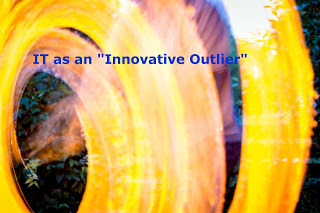Pearl Zhu's Blog, page 1235
April 19, 2017
How to Walk the Innovation Talk Effortlessly
 Digital is the era of innovation. Nowadays, many people and organizations are talking about innovation, but very few practice creativity persistently and manage innovation effectively. There is innovation friction existing and change fatigue block the way. Once people get into a routine at work, they typically get stuck at the “We always do things like that” mentality, and they do not like to hear about how things could be done differently to make the work more productive, and innovative, or finding the better way to solve either the old or existing problems. So, digital leaders, today should learn how to walk the innovation talk and manage innovation in a structural way.
Digital is the era of innovation. Nowadays, many people and organizations are talking about innovation, but very few practice creativity persistently and manage innovation effectively. There is innovation friction existing and change fatigue block the way. Once people get into a routine at work, they typically get stuck at the “We always do things like that” mentality, and they do not like to hear about how things could be done differently to make the work more productive, and innovative, or finding the better way to solve either the old or existing problems. So, digital leaders, today should learn how to walk the innovation talk and manage innovation in a structural way.
Innovation is not an aimless adventure, but a business value-driven journey: There are many areas within a company where the innovation process can be applied to create value. An Innovation ecosystem is a systematic innovation methodological environment or a sort of "professional philosophy" for innovation. An effective 'innovation system' is capable of supporting both widespread incremental innovation in products/services and ways of working as well as the rarer 'step-change' innovation in products/services, working methodologies, business models, and market positioning. Digital innovation has expanded horizon, from hard innovations such as products/service/business model innovation to soft innovations such as leadership/communication/culture innovation. Innovation ecosystem or the methodological environment should cover the whole innovation process, from processes in managing ideas or idea handling systems to idea implementation and promotion. An enriched innovation ecosystem enables systematic innovation management. A clear vision and a handy roadmap could help “keep the ends in mind,” and take the journey with faster speed. It starts with innovation strategy defines "WHAT does the organization innovate" or "where should it innovate" to support the overall strategy. The robust processes, systems, and tools that enable any entity to generate winning concepts for innovation management on the consistent basis, which is the prerequisite for sustaining advantage and growth.
Be cautious of innovation pitfalls and overcome innovation roadblocks: All humans are naturally creative. However, many silo-based work environments have overly rigid processes which stifle innovation and hidden barriers which discourage creativity. At industrial silos, people are treated as resources and cost, and most works are operational in nature; however, digital breaks down such silo thinking, it is important to create and nurture an environment in your organization where inquisitiveness and humility are appreciated, curiosity is encouraged, and creative thinking is rewarded. The talent management gurus brainstorm the idea of 'productive friction' as a way of encouraging and instilling a creative innovative environment. The top-down approach is fitter for well-planned business improvement, and the disruptive innovations more often happen from bottom up. Creativity can make many operational works more effective, doing the right things, rather than just doing the things right. A creative working environment makes the work not just a job, but a career journey full of discovery and adventure.
 Recognize innovation champions and build A+ innovative teams: Innovation is about moving forward. There is no standing still. Companies have to be prepared to lose some to gain more. In any business, if you are not moving forward, you are moving backward. It is critical to recognize your innovation champions and build high-performance creative teams. Because they set the great examples to walk the innovation talk effortlessly. However, most or organizations still think their innovators as a troublemaker and misfit, get penalized, not rewarding, those companies are obviously the innovation laggard. Creativity is an innate ability of talent people and each innovation project is driven by a passionate advocate to advance the value creation process. Thus, having a champion for each initiative is critical to success. Champions help to build productive teams. The multidisciplinary, team-based approach taps into the collective genius of innovators who can think and do things differently. It is important to strike the right balance of business stability and innovation via building a suitable and hybrid environment for stimulating creativity, encouraging originality, and measuring innovation.
Recognize innovation champions and build A+ innovative teams: Innovation is about moving forward. There is no standing still. Companies have to be prepared to lose some to gain more. In any business, if you are not moving forward, you are moving backward. It is critical to recognize your innovation champions and build high-performance creative teams. Because they set the great examples to walk the innovation talk effortlessly. However, most or organizations still think their innovators as a troublemaker and misfit, get penalized, not rewarding, those companies are obviously the innovation laggard. Creativity is an innate ability of talent people and each innovation project is driven by a passionate advocate to advance the value creation process. Thus, having a champion for each initiative is critical to success. Champions help to build productive teams. The multidisciplinary, team-based approach taps into the collective genius of innovators who can think and do things differently. It is important to strike the right balance of business stability and innovation via building a suitable and hybrid environment for stimulating creativity, encouraging originality, and measuring innovation.Walking the innovation talk is a well-prepared journey. The creative workplace is based on a triangle with three vertices: culture, method, and people. “Business Creativity" must be something to do with the customers as digital is the age of the customer, to create an interactive environment with customers, so that you can reverse engineer from customer to a creative product. Innovation needs to lay out different structures, thinking and solutions to allow this to develop into its potential where organizations are combining all that is available to them in imaginative, advantageous ways. take an innovation journey with solid footprints and create its own landscape.Follow us at: @Pearl_Zhu
Published on April 19, 2017 22:56
The New Book “Digital IT - 100 Q&As” Chapter VIII Digital IT Performance Q&As
 Many IT organizations are at the inflection point for digital transformation, they are also reinventing themselves from a cost center to a value-added business partner, and continue to improve IT efficiency, effectiveness, and agility. Hence, IT metrics need to evolve to something that matters to the business audience, at the same time that “business sentiment” needs to get put into something more tangible, such as optimize processes, or improve productivity. The various activities are needed to manage performance - strategic and operational plans, innovation metrics, day-to-day decisions. Selecting the right key performance indicator is one of the most important steps in measurement, but keep in mind, measurement is not just numbers, but stories. It is also important to spurring the healthy debates for managing IT performance effectively.
Many IT organizations are at the inflection point for digital transformation, they are also reinventing themselves from a cost center to a value-added business partner, and continue to improve IT efficiency, effectiveness, and agility. Hence, IT metrics need to evolve to something that matters to the business audience, at the same time that “business sentiment” needs to get put into something more tangible, such as optimize processes, or improve productivity. The various activities are needed to manage performance - strategic and operational plans, innovation metrics, day-to-day decisions. Selecting the right key performance indicator is one of the most important steps in measurement, but keep in mind, measurement is not just numbers, but stories. It is also important to spurring the healthy debates for managing IT performance effectively.
What are performance indicators for keeping IT and the business on the same page: To improve IT management effectiveness and efficiency, keep in mind of this management mantra “You can only manage what you measure.” CIOs need to keep a measure and periodicity at which the measure is reviewed against setting targets, ensure IT raises the bar on a continual basis to ensure the stakeholders get a real picture of how well the IT efforts are bearing desired results and keep IT and the business on the same page. An effective CIO’s job is to improve operations to reduce the burden on the company while trying to stay current with ever-changing information and technologies. That includes reducing costs, improving systems, streamlining processes and providing continually expanding services/solutions. The three keys to presenting IT values are financial returns, return timeline and risk. Just like any other investment, if you can present IT portfolio in a manner similar to an investment portfolio, it makes instant conceptual sense to board and C-level folks, make sure IT and business are always on the same page. IT metrics need to evolve to something that matters to the business audience, at the same time that “business sentiment” needs to get put into something more tangible.
What’s your focal area of IT metrics? IT leaders must keep in mind which KPIs best measure IT ability to deliver business value. The fact of the matter is that it is a lot easier to get metrics wrong than right, and the damage caused from getting them wrong usually exceeds the potential benefit from getting them right. How to measure IT effectiveness and business innovation effort directly impacts on how the business perceives IT as well as how fast IT can reach the high level of maturity. IT metric must get focused on the end-user. The end-user continues to be the key component of any bottom-line-driven business. This is where the metric for a CIO should rest, the end-user experience. The metrics which matters include some well-defined performance indicators for measuring customer satisfaction, or even constructive dissatisfaction, with the potential to optimize IT services or solutions. Overall speaking, IT metrics have to evolve from being a cost center to becoming a revenue generator. IT leaders must keep in mind which KPIs better measure IT capability to deliver business value. Track the right metrics and know what to do with them to see improvement.
 Is IT ROI hard number or fuzzy logic? IT investment in many organizations is a controversial subject. Statistically, seventy percent of technology initiatives don’t have a direct measurable effect on the bottom line. Some say IT ROI is more like fuzzy logic these days and causes negative consequences: Lack of business respect, mistrust of project intent and difficulty in entering into the mainstream strategy conversation of the company. Hence, to clarify IT investment ROI, it needs to invite the business to provide information about the potential benefit, and IT brings information about the cost, the ROI calculations should be a joint undertaking. For many CIOs, they need to be able to support essential projects with sound ROI reasoning: How to accurately project the economic impact of a proposed technology, ROI, net present value, internal rate of return and time to payback are all measurement methods CIOs must understand and use to help business leaders decide whether or not a tech investment is worth making. Each organization has specific measurable goals and objectives they have to hit through investing in IT. Use hard numbers if you can and follow “SMART” principle to measure IT performance result effectively.
Is IT ROI hard number or fuzzy logic? IT investment in many organizations is a controversial subject. Statistically, seventy percent of technology initiatives don’t have a direct measurable effect on the bottom line. Some say IT ROI is more like fuzzy logic these days and causes negative consequences: Lack of business respect, mistrust of project intent and difficulty in entering into the mainstream strategy conversation of the company. Hence, to clarify IT investment ROI, it needs to invite the business to provide information about the potential benefit, and IT brings information about the cost, the ROI calculations should be a joint undertaking. For many CIOs, they need to be able to support essential projects with sound ROI reasoning: How to accurately project the economic impact of a proposed technology, ROI, net present value, internal rate of return and time to payback are all measurement methods CIOs must understand and use to help business leaders decide whether or not a tech investment is worth making. Each organization has specific measurable goals and objectives they have to hit through investing in IT. Use hard numbers if you can and follow “SMART” principle to measure IT performance result effectively.IT plays a crucial role in optimizing business and improving organizational agility. Outcome-based measurement practices are important to focus on the performance of the entire organization. Keep in mind, financial indicators in many business situations only cover part of the story. Your measures should cover all areas that contribute to value creation including service quality, employee engagement, business competency, customer satisfaction and financial outcomes.Follow us at: @Pearl_Zhu
Published on April 19, 2017 22:51
April 18, 2017
The Monthly “Change Insight” Book Tuning: The Gains and Pains of Change Management Apr. 2017
 Change is inevitable, organizational change has become a common practice within an organization, but too often changes are made as a reaction to outer impulses, crisis, and demands. This is the bureaucracy’s way of meeting the challenges. A digital transformation is achieved via dynamic Strategy-Execution-Change life cycle management, though it is not all linear steps, but an iterative, ongoing and up-going change continuum. How to embed creativity in Change Management and lead change effortlessly? The Gains and Pains of Change Management The Gains and Pains in Change Management? Change is inevitable, and the speed of change is increasing. For individuals or organizations at the lower level of change maturity, change is a reactive action and a reluctant activity. They get stuck in the “comfort zone” for so long, dislike changes. But change is the only way to move forward. In fact, there are both gains and pains in Change Management, so how to identify, understand, and manage changes smoothly.
Change is inevitable, organizational change has become a common practice within an organization, but too often changes are made as a reaction to outer impulses, crisis, and demands. This is the bureaucracy’s way of meeting the challenges. A digital transformation is achieved via dynamic Strategy-Execution-Change life cycle management, though it is not all linear steps, but an iterative, ongoing and up-going change continuum. How to embed creativity in Change Management and lead change effortlessly? The Gains and Pains of Change Management The Gains and Pains in Change Management? Change is inevitable, and the speed of change is increasing. For individuals or organizations at the lower level of change maturity, change is a reactive action and a reluctant activity. They get stuck in the “comfort zone” for so long, dislike changes. But change is the only way to move forward. In fact, there are both gains and pains in Change Management, so how to identify, understand, and manage changes smoothly.
How to Deal With Change Management Conundrum? Change is inevitable, and the speed of changes is increasing. Forward-looking organizations are also on the journey of digital transformation. Change can be a somewhat mechanical implementation of new or different ways to doing something while the transformation is more likely to be a sweeping approach to altering a culture, or parts of it, possibly even to parts of its ecosystem, to embrace such as change and help it become self-perpetuating. When the need for significant change is identified, it's generally naive to think it will succeed without transformation as well. However, the failure rate of change management is stubbornly high - around two-thirds of change efforts fail to meet expectations. For many, change management is still a "conundrum," or one-time business initiative, what are some causes to change failure or the stagnation of digital transformation, and how to build the business “changeability” and improve its responsiveness.
How to Overcome Three Pitfalls to Accelerate Digital Paradigm Shift? Digital means the increasing speed of changes, hyperconnectivity, and always-on business dynamic. Corporate change can be a simple modification of strategy, a business process improvement or a more radical digital transformation. Either at the individual or organizational level, in the static industrial era, change is often a one-time project; in the Digital Age, change has to become an ongoing capability. But what are barriers you need to overcome in order to manage change more effectively?
 How to make Change Management Tangible rather than Fluffy? Change is the only constant, and Change Management is no longer just a one-time project or business initiative, but an ongoing business capability. However, more than two-thirds of Change efforts fail to achieve the expected result, especially for the large, legacy companies, what’re the causes of failure, and how to make Change Management tangible rather than fluffy?
How to make Change Management Tangible rather than Fluffy? Change is the only constant, and Change Management is no longer just a one-time project or business initiative, but an ongoing business capability. However, more than two-thirds of Change efforts fail to achieve the expected result, especially for the large, legacy companies, what’re the causes of failure, and how to make Change Management tangible rather than fluffy?
The Promises and Perils of Measuring Changes? Change is inevitable, and the speed of change is accelerating! For digital organizations today, Change Management is an ongoing capability, not just a one-time initiative. If you could only manage what you measure, can you make an assessment of your "Changeability," what are the promises and perils of change measurement, and how to improve the success rate of organizational Change Management?
Blogging is not about writing, but about thinking; it’s not just about WHAT to say, but about WHY to say, and HOW to say it. It reflects the color and shade of your thought patterns, and it indicates the peaks and curves of your thinking waves. Unlike pure entertainment, quality and professional content takes time for digesting, contemplation and engaging, and therefore, it takes the time to attract the "hungry minds" and the "deep souls." It’s the journey to amplify your voice, deepen your digital footprints, and match your way for human progression.Follow us at: @Pearl_Zhu
Published on April 18, 2017 23:11
What are the Barriers and Pitfalls to Build a High-Performance Board
 The contemporary corporate board plays a crucial role in overseeing business strategy and monitoring organizational performance. An effective board enables and directs management towards good outcomes, and ensure the business is on the right track to reach well-defined business goals. If the results are lacking then the board effectiveness must be questioned. More specifically, what are barriers to building a high-performance and digital ready board?
The contemporary corporate board plays a crucial role in overseeing business strategy and monitoring organizational performance. An effective board enables and directs management towards good outcomes, and ensure the business is on the right track to reach well-defined business goals. If the results are lacking then the board effectiveness must be questioned. More specifically, what are barriers to building a high-performance and digital ready board?
What are the greatest barriers to building and maintaining a high-performing board: The real BoDs dilemma is that driving the business forward is extremely difficult. This means looking into an unknown future and attempting to define the landscape with its risks and opportunities. Thus, having "deep common sense" is very important for the high-performance board. The more complicated the strategy, the worst the rates of return. Lacking "common sense," can complicate the matter, get trapped by the complexity and lose focus on critical issues. Some call common sense "informed judgment," defining it to include providing wise counsel on the broad range of issues, being able to think strategically about complex issues. High-performing boards can sense emergent opportunities, and predict potential risks, to steer the business ship to the uncharted water or the blurred digital territories. They have to prioritize and put significant efforts into governance and risk management. The ‘Deep common sense” leads toward ”Effective Judgment," which has been defined as "Applies common sense, measured reasoning, knowledge, and experience to come to a conclusion."
What tends to be the biggest gaps and “blind spots” in achieving and maintaining the right board composition? The composition of Boards should reflect approximately the profile of the company' stakeholders: shareholders, employees, customers, and suppliers. It's the diversity both from a cognitive difference or functional perspective; as the diversity of thought more often does not come from the diverse physical identity; but from one’s thinking process, cognitive difference, learning habits, experience or skill sets., etc. The question now becomes who (can or should) drive such diversity in the Boardroom and how can you make that happen? The non-executive members should be selected for their ability and willingness to constructively challenge management and this is less likely to happen if they are related to, or are close pals of, the executive members. Therefore, the “deep diverse” BoDs can practice independent thinking, bring the differentiated point of views, ideas, and capabilities to the table, and fulfill the board duty more effectively.
 What steps is your board taking to position itself for the future? Leadership is all about future, change management and also the ability to take initiative (change leadership). BoDs as top leadership roles should have multi-intelligent wisdom, to envision and lead the organization towards its future confidently. Nowadays, the speed of change is increasing and digital transformation is an inevitable journey. While there are many components of leadership, one of the most important ones is the ability to adapt, model and influence change. The corporate board as an oversight and guidance role needs to be ultra modern and super-advanced, BoDs should set the tones for change and proactively drive change with the stepwise approach to ensure the organization is moving in the right direction with an accelerated speed. The modern digital board has many responsibilities, also gets a lot of distractions. It has to laser focus on the most critical things to steering the business toward the right decision. The catalyst for the question is what appears to be a chasm between what directors claim as the priority and what actually occurs when boards are in session. Change leadership concerns the driving forces, visions, and processes that fuel large-scale transformation. Hence, a high-performance board needs to set the priority right, it has to laser focus on the most critical things, pulling enough resources and pushing the business model of technology, trustworthiness, innovation, and mastering digital fluency.
What steps is your board taking to position itself for the future? Leadership is all about future, change management and also the ability to take initiative (change leadership). BoDs as top leadership roles should have multi-intelligent wisdom, to envision and lead the organization towards its future confidently. Nowadays, the speed of change is increasing and digital transformation is an inevitable journey. While there are many components of leadership, one of the most important ones is the ability to adapt, model and influence change. The corporate board as an oversight and guidance role needs to be ultra modern and super-advanced, BoDs should set the tones for change and proactively drive change with the stepwise approach to ensure the organization is moving in the right direction with an accelerated speed. The modern digital board has many responsibilities, also gets a lot of distractions. It has to laser focus on the most critical things to steering the business toward the right decision. The catalyst for the question is what appears to be a chasm between what directors claim as the priority and what actually occurs when boards are in session. Change leadership concerns the driving forces, visions, and processes that fuel large-scale transformation. Hence, a high-performance board needs to set the priority right, it has to laser focus on the most critical things, pulling enough resources and pushing the business model of technology, trustworthiness, innovation, and mastering digital fluency.
The high performing Board shows the ability and openness to "question itself and its decisions/ discussions." It’s not talking about "second guessing" but the ability to validate and double back on decisions past and present discussions. This is basically getting the "oversight" closer to the forefront (if not within) of every board process. High-performing boards set goals for their own performance and regularly evaluate how they are performing as the board. They frequently brainstorm issues such as Board Composition, Structure, and Leadership - periodic risk assessment and well-tuned succession plans. The high-performance board makes the disproportional impact on running a high-performance business.
Follow us at: @Pearl_Zhu
Published on April 18, 2017 22:56
The New Book “Digital IT - 100 Q&As” Chapter VII IT-Business Gap Q&As
 IT-business gap is the reality, many IT organizations remain quite distinct in terms of performance metrics, structure, career path, etc. There are still numerous debates about IT and business divide with “He said, she said” scenario. Due to the hyperconnectivity nature of digital businesses, IT has to be better integrated with the business and cutting out waste in order to build a cohesive and high mature digital organization. There are quite a few classic business vs. IT debates last decades-long: Does IT still matter? What will happen to the CIO role? Is IT-business siloing a chronic problem in many organizations? etc. The positive side is Such debates, in fact, help the business and IT do more reflection via pondering deeper and understanding things from multidimensional angles.
IT-business gap is the reality, many IT organizations remain quite distinct in terms of performance metrics, structure, career path, etc. There are still numerous debates about IT and business divide with “He said, she said” scenario. Due to the hyperconnectivity nature of digital businesses, IT has to be better integrated with the business and cutting out waste in order to build a cohesive and high mature digital organization. There are quite a few classic business vs. IT debates last decades-long: Does IT still matter? What will happen to the CIO role? Is IT-business siloing a chronic problem in many organizations? etc. The positive side is Such debates, in fact, help the business and IT do more reflection via pondering deeper and understanding things from multidimensional angles.
Why does silo happen and how to bridge it? Silos happen when the “WHY?” in business is not properly communicated from the senior level management down through business units. There are different definitions of the silo, by its nature, it’s about isolation. Silos are a product of organizational insecurity and internal competition for resources. Silos are based on a culture of self-protection and judgment. Many think silo happens when the business operates from a fear standpoint - fear of rejection, fear of invisibility, etc. Silos might make you feel insulated and powerful, but they form a very insecure base for the ego which is why it never really feels good to work in an environment like that. Great organizations are supposed to maximize the individual and the group. Silo have individual goals, but someone above the silo is supposed to glue all the individual puzzle pieces together, strategic goals need to be shared and common to ensure the whole is more optimal than the sum of pieces.
Business vs. IT - the battle rages on: Where do you stand? We perpetuate the “two solitude” of IT and the business when we use the very term “IT and the business,” and even more so when we use the term “vs,” or, of course, that old chestnut “aligning IT with the business.” Digital IT needs to be embedded in almost everything we do today and will become increasingly so. To harmonize business-IT relationship, all CXOs need to play as true business leaders, not as functional managers. That said, share the reward and shame together. If IT fails, it’s also the business failure; if the business is too stifle or slow, IT needs to take a fair share of responsibility. There are often too many tech talks and not enough business talk coupled with a lack of transparency on a financial basis. IT contribution to business value does not come from the technology itself, but from the change that IT both shapes and enables. CIOs who fail to explain this to organizational leadership or continue to extol the virtues of the technology itself merely perpetuate the problem and are putting their very survival at risk. To both business and IT: Make yourself and them a part of the solution, and make yourself and them as big WE-to stop arguing, and start partnering.
 How to transform IT from the “weakest link” to the “super glue” of the business: Many businesses still perceive their IT departments as the weakest link because they feel that IT can’t keep up with their demand for new services/solutions. In other words, that IT isn’t as agile as it needs to be. From a business perspective, IT is constantly in “developing” and “demand managing” mode while business has gone far beyond that. And these are the days of business users becoming tech savvy, it is another challenge to be addressed by IT. The digital connectivity and IT consumerization bring both challenges and opportunities for IT to improve its agility and maturity. IT has to adapt to every business unit and then glue them all together. In high mature digital IT organizations, the technologists are just “IT people,” but instead, they are business partners with IT skills. To make the link strong is to enable the IT team and make them think through the business world while working on the solutions. “Super Glue IT” goes through IT governance processes. IT has categorized, prioritized, and designed solutions, bug fixes, enhancements, now with digital styles, you need to work with other leaders to make the decisions together. IT needs to be proactive and value-added, and pursue long-term goals with the strategic perspectives of the business.
How to transform IT from the “weakest link” to the “super glue” of the business: Many businesses still perceive their IT departments as the weakest link because they feel that IT can’t keep up with their demand for new services/solutions. In other words, that IT isn’t as agile as it needs to be. From a business perspective, IT is constantly in “developing” and “demand managing” mode while business has gone far beyond that. And these are the days of business users becoming tech savvy, it is another challenge to be addressed by IT. The digital connectivity and IT consumerization bring both challenges and opportunities for IT to improve its agility and maturity. IT has to adapt to every business unit and then glue them all together. In high mature digital IT organizations, the technologists are just “IT people,” but instead, they are business partners with IT skills. To make the link strong is to enable the IT team and make them think through the business world while working on the solutions. “Super Glue IT” goes through IT governance processes. IT has categorized, prioritized, and designed solutions, bug fixes, enhancements, now with digital styles, you need to work with other leaders to make the decisions together. IT needs to be proactive and value-added, and pursue long-term goals with the strategic perspectives of the business. The more salient points of the “ongoing debate,” are to brainstorm the better way to do things and run a high mature digital organization. IT must prove itself to be a business partner. Organizational success comes when IT and business act from “IT vs. business” to “IT is business” - a true partnership.Follow us at: @Pearl_Zhu
Published on April 18, 2017 22:52
April 17, 2017
The Monthly Foresight: Building Ultra-Modern Digital Organizations
 The effects of an increasingly digitalized world are now reaching into every corner of businesses and every aspect of organizations. Digital is the age of creativity and innovation, creativity is the most wanted trait for digital leaders and professionals today, and innovation is the light every organization is pursuing. Creativity is all about connecting the dots. What are your practices for building a hyperconnected and ultra-modern digital organization?
The effects of an increasingly digitalized world are now reaching into every corner of businesses and every aspect of organizations. Digital is the age of creativity and innovation, creativity is the most wanted trait for digital leaders and professionals today, and innovation is the light every organization is pursuing. Creativity is all about connecting the dots. What are your practices for building a hyperconnected and ultra-modern digital organization?How to Build an Organization of Future? The future is already here, the digital is the age of customer-centricity; the age of empathy, the age of collaboration; the age of co-creating and the age of people, but either strategically or tactically, how to build such an organization of future?The Self-Renewal Digital Organization Digital transformation is rarely a straight line. It is all about interaction, incrementalism, and innovation. The journey is far more important than the destination. Digital organizations have to adapt to the continuous changes and are able to reconfigure the organizational structure and change their own behaviors for its adaptation to environment changes and business dynamic. They are like the living systems that can self-renew in thriving as high-performance businesses. Building an Ultramodern Board to Lead Digital Transformation? At today’s “VUCA” digital dynamic, organizations face both unprecedented opportunities to grow and hyper-competition or great risks to survive. Therefore, the corporate board as the top leadership team and governance body should become the advanced mastermind behind the digital transformation, to envision, inspire, influence, and innovate. Because the substances of leadership are all about vision, change, positive influence, and progression. The spirit comes from the top, an ultramodern board can amplify leadership influence, advance the digital management mentality and lead digital transformation seamlessly. Digital Flow: The Future of Knowledge Management? Digital means flow, data flow, information flow and knowledge flow; there is a shift from more traditional knowledge management approaches to techniques that involve enhancing the "flow" of knowledge within an organization to improve access and use. As the accepted model of knowledge management is too hierarchical, too centralized for the fast-moving, increasingly social or collaborative digital enterprise of today, so it makes sense that something like flow management is seen as a more fitting.
 What are the Key Leadership Skill & Capabilities needed for the Future? The substance of leadership will never change, it is all about the future, but the leadership skills and styles need to be continually reshaped to adapt to the digital normal with VUCA characteristics. So what are the key leadership skills and digital capabilities needed for the future?
What are the Key Leadership Skill & Capabilities needed for the Future? The substance of leadership will never change, it is all about the future, but the leadership skills and styles need to be continually reshaped to adapt to the digital normal with VUCA characteristics. So what are the key leadership skills and digital capabilities needed for the future?The “Future of CIO” Blog has reached 1.8 million page views with about #3600th blog posting in 59+ different categories of leadership, management, strategy, digitalization, change/talent, etc. The content richness is not for its own sake, but to convey the vision and share the wisdom. Blogging is not about writing, but about thinking and innovating the new ideas; it’s not just about WHAT to say, but about WHY to say, and HOW to say it. It reflects the color and shade of your thought patterns, and it indicates the peaks and curves of your thinking waves. Unlike pure entertainment, quality and professional content takes time for digesting, contemplation and engaging, and therefore, it takes the time to attract the "hungry minds" and the "deep souls." It’s the journey to amplify diverse voices and deepen digital footprints, and it's the way to harness your innovative spirit.
Follow us at: @Pearl_Zhu
Published on April 17, 2017 22:55
Non Linearity as the Characteristic of Digital Ecosystem
 The digital world is a holistic ecosystem - nature, world, or the ecosystem sometimes is used interchangeably. It is all the products of a physically, chemically, biologically, cognologically, linguistically, technologically evolving nature, in that sequence. Digital is fluid, digital is also complex. It becomes complex if things do interact, particularly in the case of "non-linear" interaction, you can't separate things properly or you cannot predict the actual effect of interaction straightforwardly. In fact, nonlinearity is one of the very characteristics of digital business ecosystems.
The digital world is a holistic ecosystem - nature, world, or the ecosystem sometimes is used interchangeably. It is all the products of a physically, chemically, biologically, cognologically, linguistically, technologically evolving nature, in that sequence. Digital is fluid, digital is also complex. It becomes complex if things do interact, particularly in the case of "non-linear" interaction, you can't separate things properly or you cannot predict the actual effect of interaction straightforwardly. In fact, nonlinearity is one of the very characteristics of digital business ecosystems.When systems are not linear, they are defined as nonlinear: And ultimately, organizations need to integrate their interdependencies and ensure the business as a whole is superior to the sum of pieces. Digital boundaries are not "sharp" lines; they are fluid to adapt to changes. The digital responsibilities overlap each other. Groups of people can and do often change from one "set" of responsibilities to another one, they moved from one territory into another often nonlinearly. Complexity has increased exponentially. Imagine the complexity that comes in due to these characteristics (less structure, fewer rules and regulations, diversity, ambiguity, unpredictability, lack of linearity and increased flux) working and impacting together. The problem with setting all of your boundaries in a linear way or black and white is that others don't and it can lead to limited learning and tunnel vision. It just turns out that, as human society gets more and more complex, the very natural attempt of humans to take the very powerful techniques of mathematics, such as techniques of linear mathematics or logics and apply it to the world very quickly come up against insurmountable difficulties.
 The linear thinking implies the whole is equal to the sum of its parts, which is not effective from a digital business perspective: digital enterprises are inherently and intensely complex. Moreover, these changes and more do not happen in isolation from each other in predictable ways. They act as a complex and unpredictable system, feeding, amplifying or ameliorating the effects of others and shaping organizational structure and system. The applying of non-linear thinking has to do with complex problem-solving. Thus, nonlinear thinking is more effective for problem-solving in the complex digital world today. From linear to nonlinear thinking could be evolutionary. Bridging the gaps between linear and nonlinear thinking can significantly help improve business effectiveness. At the beginning, you often make a one-dimensional, linear, list of things to do. At the end when you have gone through the mufti-dimensional analysis or process, when everything else is in place you again have a list of what you need to do, to practice nonlinear thinking and holistic problem-solving.
The linear thinking implies the whole is equal to the sum of its parts, which is not effective from a digital business perspective: digital enterprises are inherently and intensely complex. Moreover, these changes and more do not happen in isolation from each other in predictable ways. They act as a complex and unpredictable system, feeding, amplifying or ameliorating the effects of others and shaping organizational structure and system. The applying of non-linear thinking has to do with complex problem-solving. Thus, nonlinear thinking is more effective for problem-solving in the complex digital world today. From linear to nonlinear thinking could be evolutionary. Bridging the gaps between linear and nonlinear thinking can significantly help improve business effectiveness. At the beginning, you often make a one-dimensional, linear, list of things to do. At the end when you have gone through the mufti-dimensional analysis or process, when everything else is in place you again have a list of what you need to do, to practice nonlinear thinking and holistic problem-solving.Understanding nonlinearity as the very characteristic of the digital organization and business ecosystem could be at the tipping point for the digital paradigm shift. It means that the shift from a silo, linear classic management style to holistic to the nonlinear management discipline. It is transformational and profound (unparalleled in management history). Enterprises of the future are increasingly exhibiting such characteristics in various shades and intensity. Via practicing nonlinear thinking and holistic digital management, the future of digital organizations would be complex enough to act intelligently and nimble enough to adapt to the change promptly. Follow us at: @Pearl_Zhu
Published on April 17, 2017 22:51
The New Book “Digital IT - 100 Q&As” Chapter VI Digital IT Priority Q&As
 Modern businesses often get trapped into “busyness,” overwhelmed with too many projects or change initiatives, and overloaded with short-term business concerns. Hence, it is important to set the right priority for improving management effectiveness and maturity. Prioritization starts with a right mindset, to laser focuses on the most critical challenge the business needs to overcome and spur healthy debates on how to manage the business resource and talent effectively via prioritization and optimization.
Modern businesses often get trapped into “busyness,” overwhelmed with too many projects or change initiatives, and overloaded with short-term business concerns. Hence, it is important to set the right priority for improving management effectiveness and maturity. Prioritization starts with a right mindset, to laser focuses on the most critical challenge the business needs to overcome and spur healthy debates on how to manage the business resource and talent effectively via prioritization and optimization.
How to manage and prioritize business requirement for IT initiatives? IT is business, every IT initiative needs to have a well-defined business requirement and well-supported business sponsors. The requirement management is a good starting point and one of the significant steps in managing IT initiative effectively to achieve its business value. IT initiative are business projects, and therefore, require participation by the entire business. As requirements are gathered, managed, and discussed with executives and teams, focus on those requirements whose improvement has the most benefit to the business, and keep the stakeholders focused on those requirements and relationships. So IT has to oversee the full set of the requirements to ensure the cohesiveness and to determine all the customers, users, and stakeholders, and obtain their involvement. The challenging is really about helping the sponsors, being able to ask the right questions and fitting together different strategy components. The business requirement management directly impacts on how successful such initiatives can not only be delivered on time or on a budget, but, more importantly, on value, and reach customers’ expectations.
What are the prioritization challenges for CIOs to run high performance IT? IT is the only function in an organization which has the touch point with all other functions and provides the necessary integration between them through efficient business processes and information systems. CIOs need to have information technology insight and foresight upon potential opportunities to retool business, reimagine growth possibilities and manage innovation effectively. IT plays a significant role in modern businesses to ensure the right people can get the right information at the right time to make the right decisions for either business problem-solving or customer delight. IT is often understaffed and overloaded, in order to gain respect from the business and build a good reputation as a trustful business partner for the long term, it is both the art and science to know when to say “Yes,” and when to say “No,” to your internal customers, IT needs to act as the trustful business partner to advise the business for figuring out the better solution, not just the customer asking for. The challenge for running high performance IT is to set the right priority, manage the limited budget and resource, to “Do more with innovation,” acquire and deploy appropriate technologies and services to achieve significant business goals and objectives.
 How to set the right priority for running digital IT with full speed? IT plays a significant role in the digital transformation of the organization because information is permeating into every corner of the business and digital technologies are often the disruptive forces of digital innovation. However, the majority of IT organizations still get stuck in the lower level of maturity, slow to change, and operate in a “surviving mode.” IN some well-established organizations, IT is the controller with a bit “arrogant” attitude, without doing enough to engage the business into collecting requirement and setting priority. Hence, IT leaders need to have the strategic mind and skillset to contribute to both business problem defining and solving. IT should play as an optimistic innovator and a cautious digital accelerator, with an in-depth understanding of technology potential and limitation, opportunity, and risks. The CIO can only set the right priority choice and speed up to drive changes if they have the information available to them and proactively understand business and customer first to avoid changing for the technology’s sake. So IT can run with full speed without too many distractions and misunderstanding.
How to set the right priority for running digital IT with full speed? IT plays a significant role in the digital transformation of the organization because information is permeating into every corner of the business and digital technologies are often the disruptive forces of digital innovation. However, the majority of IT organizations still get stuck in the lower level of maturity, slow to change, and operate in a “surviving mode.” IN some well-established organizations, IT is the controller with a bit “arrogant” attitude, without doing enough to engage the business into collecting requirement and setting priority. Hence, IT leaders need to have the strategic mind and skillset to contribute to both business problem defining and solving. IT should play as an optimistic innovator and a cautious digital accelerator, with an in-depth understanding of technology potential and limitation, opportunity, and risks. The CIO can only set the right priority choice and speed up to drive changes if they have the information available to them and proactively understand business and customer first to avoid changing for the technology’s sake. So IT can run with full speed without too many distractions and misunderstanding.
There is no one size fits all formula to run a high-effective IT with accelerated speed. Because different IT organizations evolve digital with the different speed, and the enterprise as a whole is at the different stage of reaching business maturity. By setting the right priority and focusing resources and budget on the most critical areas, IT has the opportunity to not only be responsive but ultimately be strategic partner capable of helping lines of businesses thrive by proactively driving digital transformation.
Follow us at: @Pearl_Zhu
Published on April 17, 2017 22:46
April 16, 2017
The Monthly “IT Innovation” Book Tuning Apr. 2017
 IT plays a significant role in managing information-knowledge-insight cycle and fostering innovation by leveraging disruptive technologies and enriched information flow. But more specifically, how can IT build differentiated capabilities to become an information power center and an innovation hub? The purpose of “IT innovation - Reinvent IT for the Digital Age” is to help business and IT leaders and digital professionals ride above the learning curve, reinvent IT as an innovation hub and game changer; reimagine IT as an innovation outlier; renovate a hybrid IT and digital organization; fine-tune IT as the digital whole brain of the organization; accelerate IT on the fast lane, rebuild IT as the business capability multiplier; empower IT as a digital change agent; and leverage the “alphabetic elements” to run a highly innovative IT organization for the digital age.
IT plays a significant role in managing information-knowledge-insight cycle and fostering innovation by leveraging disruptive technologies and enriched information flow. But more specifically, how can IT build differentiated capabilities to become an information power center and an innovation hub? The purpose of “IT innovation - Reinvent IT for the Digital Age” is to help business and IT leaders and digital professionals ride above the learning curve, reinvent IT as an innovation hub and game changer; reimagine IT as an innovation outlier; renovate a hybrid IT and digital organization; fine-tune IT as the digital whole brain of the organization; accelerate IT on the fast lane, rebuild IT as the business capability multiplier; empower IT as a digital change agent; and leverage the “alphabetic elements” to run a highly innovative IT organization for the digital age.
Running a High Innovative IT OrganizationCIO as Chief Innovation Officer? Nowadays information is the lifeblood, and the emergent technology is more often the business disruptor. And due to the changing nature of information & technology, IT is always in the changing environment creating unexpected situations and requiring quick and appropriate responses based on the conditions. As businesses embark on the “digital Era” of computing (Cloud, Big Data, Mobile, Social). how will IT have to change? What is the nature of the new IT leadership and what is the primary role of the CIO in harnessing the IT leadership?
An Innovative IT: From industry surveys, the majority of IT organizations are still being perceived as maintenance center, most employees outside of IT don’t call their IT teams very innovative, yet most believe technology is growing in importance, so IT leaders are facing unprecedented pressures to transform their IT into value center and innovation engines, but how to run an innovate IT, what’re the roadblocks one need to overcome, and which capabilities IT needs to cultivate?
IT Paradox: Should Creativity and Process go Hand in Hand? Today, organizations have to compete on a global scale and creativity is not only valuable from a products/service standpoint, but can also add efficiency or effectiveness to IT operations, improving business-IT communication, innovate business culture, and provide for outside-the-box problem-solving capability as well.
How does IT handle investigations of innovative business solutions? IT plays a critical role in building business competency. IT has itself transformed to creating a new competitive advantage via building new products, new services and delivering tailored business solutions. But many of today’s C-suites are unaware of what is technologically possible now or in the future. Digital is the age of options, it provides the opportunity to think the new way to do things, so it forces IT leaders, to get really creative on how they architect and implement change, and how IT handles investigation of innovative business solutions, to change the business’s perception, reinvent its tarnished reputation and improve the overall business maturity.
 A set of Q&As (X) Dealing with IT Innovation Paradox Modern CIOs face many challenges, it is not sufficient to only keep the lights on. Regardless of which industry or the nature of organization you are in, being a digital leader will need to master the art of creating unique, differentiating value from piles of commoditized technologies and take advantage of the emergent digital trend as well; digital CIOs also have multiple personas, “Chief Innovation Officer,” “Chief Insight Officer,” “Chief Improvement Officer,” “Chief Information Officer,” and here, we discuss CIOs as “Chief Inquisitive Officer,” with a set of Q&As to lead digital transformation.
A set of Q&As (X) Dealing with IT Innovation Paradox Modern CIOs face many challenges, it is not sufficient to only keep the lights on. Regardless of which industry or the nature of organization you are in, being a digital leader will need to master the art of creating unique, differentiating value from piles of commoditized technologies and take advantage of the emergent digital trend as well; digital CIOs also have multiple personas, “Chief Innovation Officer,” “Chief Insight Officer,” “Chief Improvement Officer,” “Chief Information Officer,” and here, we discuss CIOs as “Chief Inquisitive Officer,” with a set of Q&As to lead digital transformation.
The “Future of CIO” Blog has reached 1.8 million page views with about 3600+ blog posting in 59+ different categories of leadership, management, strategy, digitalization, change/talent, etc. The content richness is not for its own sake, but to convey the vision and share the wisdom. Blogging is not about writing, but about thinking; it’s not just about WHAT to say, but about WHY to say, and HOW to say it. It reflects the color and shade of your thought patterns, and it indicates the peaks and curves of your thinking waves. Unlike pure entertainment, quality and professional content takes time for digesting, contemplation and engaging, and therefore, it takes the time to attract the "hungry minds" and the "deep souls." It’s the journey to amplify your voice, deepen your digital footprints, and match your way for human progression.
Follow us at: @Pearl_Zhu
Published on April 16, 2017 22:04
Digital Boards as “Leadership Masters”
 The board in a high-level leadership position plays a crucial role in business advising and monitoring, as well as setting key digital tones in organizational culture style and leadership quintessential. A high mature digital board is like a brighter light tower to guiding the business toward the right direction and take all these significant responsibilities more “thoughtfully.” Here are three leadership inquiries help digital BoDs sharpen their leadership capabilities and improve their directorship effectiveness.
The board in a high-level leadership position plays a crucial role in business advising and monitoring, as well as setting key digital tones in organizational culture style and leadership quintessential. A high mature digital board is like a brighter light tower to guiding the business toward the right direction and take all these significant responsibilities more “thoughtfully.” Here are three leadership inquiries help digital BoDs sharpen their leadership capabilities and improve their directorship effectiveness.
Is the next generation of leaders stepping up? Who is choosing to lead in these uncertain times? The substance of leadership will never change, it is the vision to make the positive influence, to lead your organization and the world forward, not backward. Leadership is about a clear vision and a planned attitude of free mind, risk-taking, initiative, and innovation. On one hand, leadership becomes more open and omnipresent in digital era because the hierarchy of an organization is flatter due to the latest digital disruption. On the other hand, the leadership bar is raised because the leadership reputation can not be built through certain static credential or a few spotlight moments, the world has become more connected and transparent. Leadership is no longer just about a title or a position or some soft skills only, it is the set of hard capabilities to both connect the minds and touch the hearts. Great leaders today need extraordinary vision and differentiated capabilities, and more importantly how to convey and interpret their vision via creative communication, as well as the ability to lead the team for reaching the vision seamlessly. Hence, from the boardroom to the front line, every authentic leader needs to mind certain gaps and bridge the cognitive difference. First and foremost, remove the filter of your biases in your vision. By doing so, you will be able to perceive the business opportunities and risks more clearly.
Is the current leadership asking for help across the organization? At the industrial age, the ones in leadership positions assume they have all the answers because the business is considerably static and there’s scarcity of information, and many managers live in their own silo and advocate “we always do things this way.” However, digital means changes and abundant information, Besides soft quality, the hard core of leadership is knowledge, insight, and wisdom in order to make sound judgments and solid decisions. Further, at today’s information overloading business dynamic, leaders need to be able to prioritize their work and manage their time more effectively, laser focus on the critical things which really matter; sadly this is one area that is lacking in many areas which then results in a drop in leadership effectiveness. Digital leaders today need to become more inquisitive, creative and informative. Knowledge sharing and understanding organizational culture is a way to start, they should always eager to understand the other side of the coin, complement each other’s skills, and continue each other’s sentences for cultivating the culture of learning.
 Is the culture of the organization that allows people to lead without authority? Leadership does not mean being followed up by followers based on titles only. To be an inspiring digital leader, an individual has to prove him/herself of a free mind, risk-taking, multidimensional intelligence, and innovation. There is healthy leadership and unhealthy leadership. Healthy leaders seek people who demonstrate the true interest in growing, purpose discovery and contributing to something larger and becoming better at the strengths they possess. Unhealthy leadership practices enforce the industrial silo or focus on “cookie-cutting,” choose people lacking independent thinking or thought leadership, which may lead to authoritarianism, egotism or even unprofessionalism. You need to clarify and understand that the role of a leader is to create a high-performance environment where success is inevitable. Combined with the role, the purpose of leadership is to cultivate more authentic leaders and awaken possibility in people to deliver extraordinary results. A digital leader creates more authentic leaders, not his/her own copy, but be authentic for their own purposes.
Is the culture of the organization that allows people to lead without authority? Leadership does not mean being followed up by followers based on titles only. To be an inspiring digital leader, an individual has to prove him/herself of a free mind, risk-taking, multidimensional intelligence, and innovation. There is healthy leadership and unhealthy leadership. Healthy leaders seek people who demonstrate the true interest in growing, purpose discovery and contributing to something larger and becoming better at the strengths they possess. Unhealthy leadership practices enforce the industrial silo or focus on “cookie-cutting,” choose people lacking independent thinking or thought leadership, which may lead to authoritarianism, egotism or even unprofessionalism. You need to clarify and understand that the role of a leader is to create a high-performance environment where success is inevitable. Combined with the role, the purpose of leadership is to cultivate more authentic leaders and awaken possibility in people to deliver extraordinary results. A digital leader creates more authentic leaders, not his/her own copy, but be authentic for their own purposes. Contemporary digital boards set the critical tones from leadership grooming to talent/culture development. The board provides an “outside-in” view of the business and multi-dimensional lenses to oversee and advise business strategy execution and steer business toward the right direction effortlessly. The digital boards are also leadership masters who can both walk the talk and talk the walk seamlessly to lift digital leadership maturity. Follow us at: @Pearl_Zhu
Published on April 16, 2017 21:59



